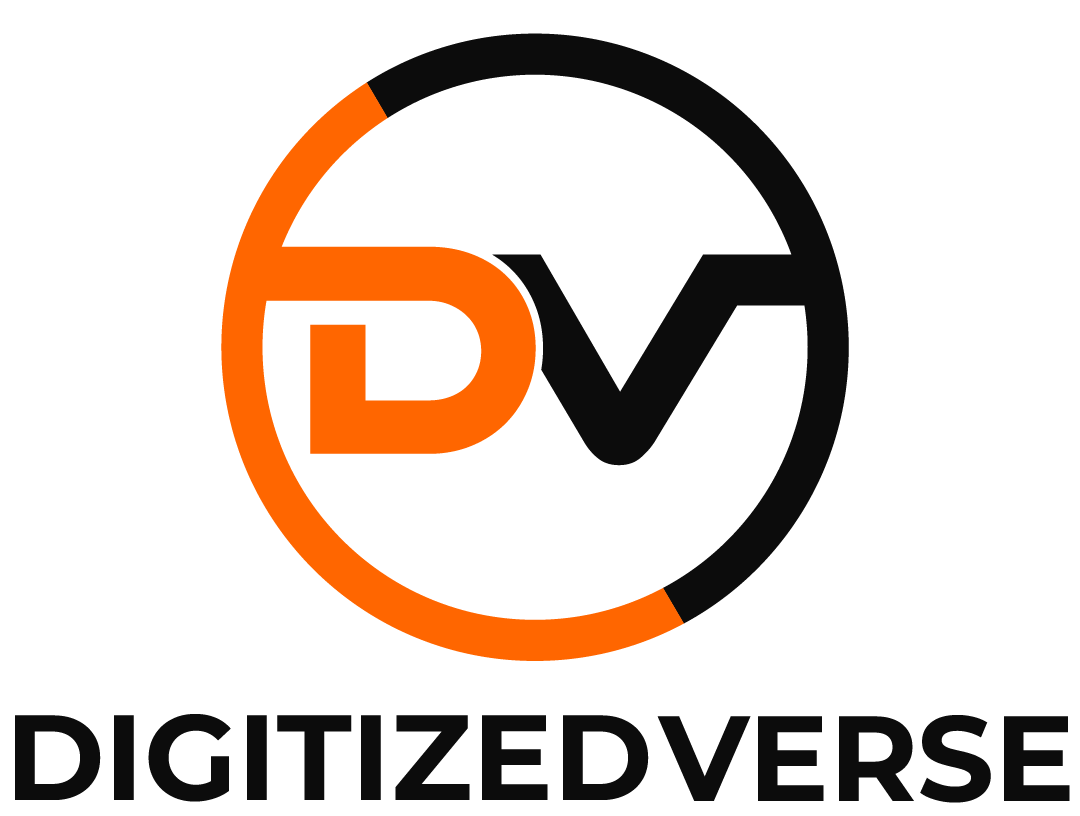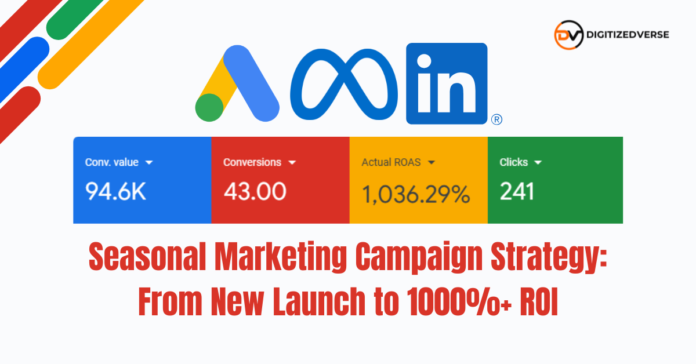Launching a new eCommerce brand in a competitive market is never easy—especially when you have no existing customer base. Yet, with the right Seasonal Marketing Campaign Strategy, even a new product can outperform established competitors.
In this guide, you’ll learn how one new eCommerce client achieved over 1000% ROI during a seasonal sale period using a structured, data-driven approach. We’ll break down the seasonal campaign framework, timeline, and performance principles you can replicate for your own success.
Understanding the Power of a Seasonal Marketing Campaign Strategy
A Seasonal Marketing Campaign Strategy focuses on aligning your launch, ads, and offers with consumer demand peaks throughout the year—such as holiday sales, Black Friday, or local shopping events.
When executed correctly, this approach not only boosts conversions but also improves brand awareness, ad performance, and customer acquisition efficiency.
Pillar 1: Seasonality — Timing and Opportunity
Timing defines the success of every seasonal marketing campaign. Launching when your target audience is already in a buying mindset can dramatically increase ROI.
Key Steps
- Choose the right launch window: Identify high-demand dates such as Black Friday, Valentine’s Day, or regional shopping festivals.
- Validate demand: Use Google Trends, marketplace data, and competitor analysis to confirm buyer intent.
- Align inventory and logistics: Prepare for volume spikes in orders, shipping, and returns.
- Build a promotional calendar: Map out pre-launch teasers, launch day, peak day, and post-launch phases.
Pro Tip: Launching slightly ahead of competitors gives your ads room to stabilize before the surge in CPCs and competition.
Pillar 2: Research and Planning — The Foundation of Every Seasonal Marketing Campaign
Effective seasonal campaigns begin with research. Knowing who you’re targeting and how your product fits their needs determines whether your ad budget converts profitably.
Strategic Planning Steps
- Audience definition: Identify your top two or three buyer personas, their interests, and purchasing behavior.
- Product positioning: Clarify your unique value proposition and align pricing with perceived value.
- Creative planning: Prepare visuals, short videos, carousel ads, and UGC to test multiple angles.
- Offer design: Develop bundles, tiered discounts, and urgency-based offers to drive faster decisions.
Tip: Researching competitors’ ad libraries (Meta, TikTok, or Google) helps you spot creative gaps and opportunities for differentiation.
Pillar 3: Execution — Running Campaigns That Convert
A great Seasonal Marketing Campaign Strategy doesn’t end with planning—it’s the execution that turns data into ROI.
Recommended Campaign Structure
- Prospecting (Cold Traffic): 60–70% of the budget
- Retargeting (Warm Traffic): 25–35%
- Loyalty or Retention Campaigns: 5–10%
Ad Mix
- Video ads for awareness and storytelling
- Carousel ads to highlight product benefits or bundles
- Dynamic product ads for personalized retargeting
Optimization Framework
- Test 5–10 creatives and 2–3 audience segments.
- Pause underperforming ads early and reallocate budget to winners.
- Scale gradually (20–30% budget increases) to maintain consistency.
Integrating Google Ads with Meta Ads ensures you reach both high-intent and discovery audiences.
Pillar 4: Smart Investment and Process Management
A profitable seasonal sales marketing plan requires balance between testing and scaling.
Best Practices
- Allocate 10–20% of your budget for creative and audience testing.
- Focus on high-intent channels like Google Search, Shopping, and Retargeting during launch.
- Combine manual and automated bidding—begin manually (Target CPA or Max Conversions), then switch to automation once data stabilizes.
- Keep a detailed testing log of experiments, outcomes, and learnings.
Treat every campaign as a data-driven experiment—each result contributes to a repeatable framework.
Tracking and Analytics Setup
Before launching your eCommerce seasonal campaign, ensure accurate tracking and reporting.
- Connect Google Analytics 4 with Google Ads.
- Configure conversion events such as purchases, cart additions, and checkouts.
- Implement consistent UTM parameters for campaign tracking.
- Verify Meta, TikTok, or Pinterest pixels are firing correctly.
- Test the checkout process and conversion goals.
Strong data integrity ensures reliable decision-making throughout your Seasonal Marketing Campaign Strategy.
8-Week Seasonal Launch Timeline
| Week | Stage | Key Focus |
|---|---|---|
| -8 | Research | Product positioning, offer planning |
| -6 | Creative | Video and image production |
| -4 | Technical | Tracking and QA setup |
| -2 | Soft Launch | Low-budget test campaigns |
| 0 | Launch Week | Full-scale campaign rollout |
| +1–4 | Optimization | Scaling winners, retargeting, retention |
A timeline like this creates a predictable rhythm for execution and optimization, reducing last-minute errors.
Pre-Launch Checklist
- Tracking (GA4, Google Ads, Meta Pixel, GTM) configured
- Payment gateways, SSL, and domain tested
- Inventory and shipping confirmed
- Creative bank prepared (videos, carousels, UGC)
- Discount codes and promo assets ready
- Customer support channels operational
A solid checklist guarantees a smooth launch and consistent ad performance.
Measuring Success: Key KPIs
Daily Metrics
- Ad Spend
- Click-Through Rate (CTR)
- Cost-Per-Click (CPC)
- Conversions and CPA
Weekly Metrics
- Return on Ad Spend (ROAS)
- Conversion Rate
- Average Order Value (AOV)
- Customer Acquisition Cost (CAC)
Post-Campaign Analysis
- Lifetime Value (LTV) vs CAC
- Profitability by SKU or product line
- Top audiences and creatives for scaling
Post-Campaign Optimization
After your seasonal ad campaigns conclude, conduct a detailed post-analysis.
- Measure ROI by channel and audience segment.
- Identify top-performing ad formats, creatives, and landing pages.
- Create a scaling framework based on proven winners.
- Plan retention through email marketing, SMS flows, and loyalty offers.
Each campaign becomes a foundation for the next, improving efficiency with every cycle.
Templates and Practical Examples
UTM Example:utm_source=google&utm_medium=cpc&utm_campaign=holiday2025_p1&utm_content=videoA
Campaign Naming Example:C1-Prospect-Video-Test, C2-Retarget-Cart-Carousel, C3-Loyalty-Retention-Email
Budget Example ($5,000):
- Prospecting → $3,250 (65%)
- Retargeting → $1,500 (30%)
- Loyalty → $250 (5%)
Case Study: 1000%+ ROI During a Seasonal Sale
A newly launched eCommerce brand with zero prior audience achieved 1000% ROI during a 6-week holiday campaign using this exact Seasonal Marketing Campaign Strategy.
Key Success Factors:
- Strategic timing aligned with seasonal demand
- Data-backed ad targeting
- Multi-channel execution
- Efficient budget allocation
- Smart scaling and consistent optimization
This result proves that even new brands can dominate competitive markets with a well-structured seasonal campaign framework.
Conclusion
A successful Seasonal Marketing Campaign Strategy is built on four pillars: seasonality, research, execution, and smart investment.
By following a clear framework and maintaining disciplined optimization, even a small brand can achieve breakthrough performance during seasonal peaks.
With the right timing, creative execution, and analytical discipline, your next seasonal marketing campaign can deliver exceptional ROI—just like our 1000% success case.
Contact a certified Google Ads expert to plan your next seasonal campaign and unlock your full growth potential. (Irtiza Ahmed – Google Ads Expert)




